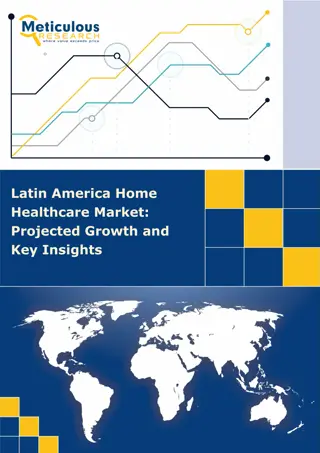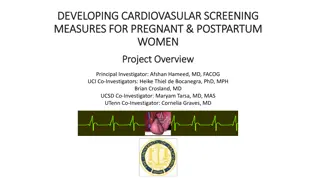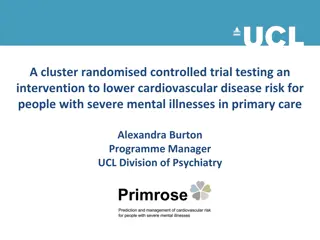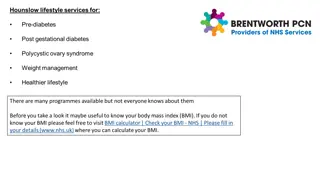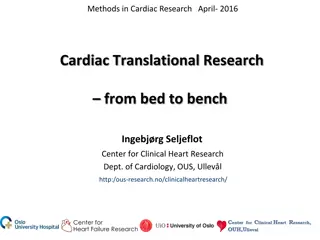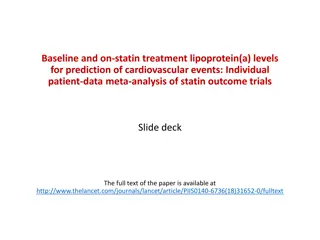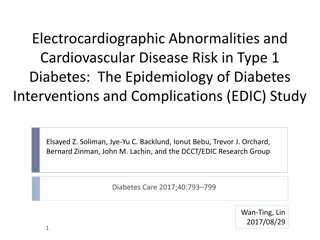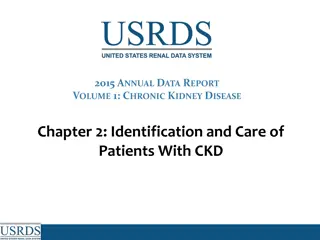Cardiovascular Diseases
Cardiovascular diseases (CVD) encompass various conditions such as coronary heart disease, stroke, hypertension, and heart failure, leading to significant global mortality. Developed countries show decreasing trends due to lifestyle improvements and better medical interventions, while developing nations face a rising burden. Over 300 risk factors, including high blood pressure and unhealthy habits, contribute to CVD, with modifiable factors like smoking and obesity playing a critical role. Addressing these risk factors is key to reducing CVD prevalence and improving public health across diverse populations.
Download Presentation

Please find below an Image/Link to download the presentation.
The content on the website is provided AS IS for your information and personal use only. It may not be sold, licensed, or shared on other websites without obtaining consent from the author.If you encounter any issues during the download, it is possible that the publisher has removed the file from their server.
You are allowed to download the files provided on this website for personal or commercial use, subject to the condition that they are used lawfully. All files are the property of their respective owners.
The content on the website is provided AS IS for your information and personal use only. It may not be sold, licensed, or shared on other websites without obtaining consent from the author.
E N D
Presentation Transcript
- Coronary heart disease (CHD, ischemic heart disease, heart attack, myocardial infarction, angina pectoris) - Cerebrovascular disease (stroke, TIA, transient ischemic attack) - Hypertensive heart disease - Peripheral vascular disease - Heart failure - Rheumatic heart disease (streptococcal infection) - Congenital heart disease - Cardiomyopathies
In the world: CVD deaths account for one third of all deaths (25-50% depending on the level of economic development) among which 50%: coronary deaths CVD made up 16.7 million of global deaths in 2002, among which 7 million due to coronary heart disease, 6 million due to stroke
Developed countries: decreasing tendencies (e.g, USA: 30% between 1988-98, Sweden: 42%) - improvement of lifestyle factors, for example, a decrease of smoking and a higher level of health consciousness in many developed countries - better diagnostic and therapeutic procedures (e.g., bypass surgeries, hypertension screening, pharmacological treatment of hypertension and hypercholesterinaemia, access to health care) Developing countries: increasing tendencies - increasing longevity, urbanization, and western type lifestyle
Over 300 risk factors have been associated with coronary heart disease, hypertension and stroke Approx. 75% of CVD can be attributed to conventional risk factors Risk factors of great public health significance: - high prevalence in many populations - great independent impact on CVD risk - their control and treatment result in reduced CVD risk Developing countries: double burden of risks (problems of undernutrition and infections + CVD risks)
Major modifiable risk factors - High blood pressure - Abnormal blood lipids - Tobacco use - Physical inactivity - Obesity - Unhealthy diet - Diabetes mellitus Non-modifiable risk factors - Age - Heredity or family history - Gender - Ethnicity or race Other modifiable risk factors - Low socioeconomic status - Mental ill health (depression) - Psychosocial stress - Heavy alcohol use - Use of certain medication - Lipoprotein(a) Novel risk factors - Excess homocysteine in blood - Inflammatory markers (C- reactive protein) - Abnormal blood coagulation (elevated blood levels of fibrinogen)
Question: What is the relative amount of CVD in death rates in different age groups? - Early lesions of blood vessel, atherosclerotic plaques: around 20 years - adult lifestyle patterns usually start in childhood and youth (smoking, dietary habits, sporting behavior, etc.) - Increase in CVD morbidity and mortality: in age-group of 30-44 years - Premature death (<64 years of age, or 25-64 years): in the elderly population more difficult to interpret death rate due to multiple ill health causes
PROPORTION OF MORTALITY IN DIFFERENT AGE-GROUPS (MEN) 4,7% 100% 14,0% 14,9% 90% 80% 26,0% 61,5% 24,6% 70% external others cancer CVD 60% 50% 26,9% 40% 55,8% 22,5% 30% 32,7% 20% 11,4% 10% 4,6% 0% 1-24 yrs 25-64 yrs >65 yrs
PROPORTION OF MORTALITY IN DIFFERENT AGE-GROUPS (WOMEN) 4,8% 100% 8,2% 90% 18,3% 40,0% 24,0% 80% 12,2% 70% external others cancer CVD 60% 36,5% 50% 35,0% 40% 64,7% 30% 20% 17,7% 31,3% 10% 7,3% 0% 1-24 yrs 25-64 yrs >65 yrs
Question: What is the relative amount of CVD in death rates in women and men? CVD affect nearly as many women as men, albeit at an older age - Women: special case (WHO, 2004) a., Higher risk in women than men (smoking, high triglyceride levels) b., Higher prevalence of certain risk factors in women (diabetes mellitus, depression) c., Gender-specific risk factors (risks for women only) (oral contraceptives, hormone replacement therapy, polycystic ovary syndrome)
Question: What is the relative amount of CVD in death rates in different ethnic groups? - In the US: increased cardiovascular disease deaths in African-American and South-Asian populations in comparison with Whites - Increased stroke risk in African-American, some Hispanic American, Chinese, and Japanese populations - Migration: Ni-Hon-San Study: Japanese living in Japan had the lowest rates of CHD and cholesterol levels, those living in Hawaii had intermediate rates for both, those living in San Francisco had the highest rates for both
- Regular physical activity: protective factor - Intensity and duration (150 minutes/week intermediate or 60 minutes/week heavy) - Modernization, urbanization, mechanized transport: sedentary lifestyle (60% of global population) - Raises CVD risk and also the development of other risk factors (glucose metabolism, diabetes mellitus, blood coagulation, obesity, high blood pressure, worsening lipid profile) - Physical activity: helps reduce stress, anxiety and depression
Altering functions of cholesterol fractions (LDL: risk, HDL: protection) - Estrogen: tends to raise HDL-cholesterol and lower LDL-cholesterol, protection for women in reproductive age - Partially genetic determination of metabolism, partially dependent of nutrition (egg, meats, dairy products)
European guidelines US guidelines Total cholesterol <5.0 mmol/l <240 mg/dl (6.2 mmol/l) LDL-cholesterol <3.0 mmol/l <160 mg/dl (3.8 mmol/l) HDL-cholesterol >=1.0 mmol/l (men) >=1.2 mmol/l (women) >=40 mg/dl (1 mmol/l) Triglycerides (fasting) <1.7 mmol/l <200 mg/dl (2.3 mmol/l)
- The link between smoking and CVD (mainly CHD) was identified in 1940 - Greatest risk: initiation < 16 years - Passive smoking: additional risk - Women smokers: are at higher risk of CHD and CVD than male smokers
damages the endothelium lining, increases atherosclerotic plaques, raises LDL and lowers HDL, promotes artery spasms, raises oxigen demand of the heart muscle - Nicotine accelerates the heart rate (RR), and raises blood pressure
- Body Mass Index: > 25: overweight, > 30: obesity - A modern epidemic : More than 60% of adults in the US are overweight or obese, in China: 70 million overweight people - Elevates the risk of both CVD and diabetes mellitus - Diabetes mellitus: damages both peripheral and coronary blood vessels -Unhealthy diet: low fruit and vegetable, fiber content, and high saturated fat intake, refined sugar
Primordial: Social, legal and other (often nonmedical) activities which may lead to a lowering of risk factors (e.g., socioeconomic development, smoke-free restaurants) Primary: Controlling risk factors contributing to CVD (health education programs, anti-smoking campaign, sports programs, nutrition counselling)
Secondary: Screening and treatment of symptomatic patients, set up personal risk profile Tertiary: Cardiovascular rehabilitation, prevention of recurrence of CVD (new heart attack: 5-7 times higher risk among CVD patients)







